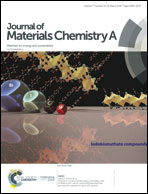Bi-functional additive engineering for high-performance perovskite solar cells with reduced trap density†
Abstract
Even though organic–inorganic halide perovskite solar cells (PSCs) have rapidly emerged as one of the most promising candidates for photovoltaic applications, simultaneously achieving a controlled microstructure and subdued trap states has proven to be challenging. In this work, ammonium benzenesulfonate (ABS) is introduced as a coordination and passivation molecule into a perovskite to improve the film quality and reduce defect densities. ABS can not only form the intermediate phase with precursor materials to decrease the crystallization rate, but also passivate both cationic and anionic defects at grain boundaries due to its zwitterionic structure. The trap density is significantly reduced, as demonstrated qualitatively by the confocal photoluminescence (PL) and time-resolved photoluminescence (TRPL) mapping images and quantitatively by trap density of states measurement, leading to suppressed trap-induced non-radiative recombination and elongated carrier lifetimes. The highest device efficiency of 20.62% is achieved by the introduction of ABS, mainly originating from the improvement of Voc and FF. The moisture and oxygen tolerance of unencapsulated devices are also enhanced, with only 15% degradation of the initial efficiency after storage for 1400 h in an ambient environment with ≈30% humidity. This strategy offers a simple method to fabricate high-quality and low-defect perovskite films, demonstrating the potential of these high-performance PSCs for large-scale production.



 Please wait while we load your content...
Please wait while we load your content...